A Numerical Approach to Predict Water Levels in Ungauged Regions—Case Study of the Meghna River Estuary, Bangladesh
Abstract
:1. Introduction
1.1. Physical Settings of Estuary
1.2. Hydrological Settings
2. Materials and Methods
2.1. Hydrodynamic Model
2.2. Meghna Estuarine River Modelling (Methodology)
2.2.1. Modeling and Calibration
2.2.2. Analytic Prediction of Water Levels
2.3. Computational Domain
2.4. Water Level and Inflow Boundary Conditions
3. Results
3.1. Model Calibration
3.1.1. Calibration for Dry Season (January)
3.1.2. Calibration for Rainy Season (June to August)
3.2. Hydrodynamic Components
3.3. Water Level Prediction in Un-Gauged Regions
4. Discussion
4.1. Numerical Model of Estuary
4.2. Implications of Water Level Prediction
5. Conclusions
- The hydrodynamic model produced temporal and spatial distributions of the tidal water level recurrently within the sea, main rivers, small channels, natural banks, and whole domain. The water level prediction of the hydrodynamic model was produced and evaluated, as the simulated values were compared to 126 real time observations from Chandpur river gauges.
- The hydrodynamic model was calibrated by adjusting bed resistance with the minimum prediction errors for both dry and rainy seasons, indicating seasonal differences in hydrodynamic components. Therefore, it was possible to find an optimized set of simulation factors. Moreover, this means that the results provided a possibility for their prediction, as they have shown good agreement between the data collected and the simulation results.
- Within the results generated by numerical analysis, it was possible to conduct a frequency analysis to develop a return period for upstream and downstream boundary conditions. With this analysis, it is possible to develop boundary conditions by matching them with the return period and to predict water levels for overall stations in the Meghna estuary by numerical modelling.
Acknowledgments
Author Contributions
Conflicts of Interest
References
- Unite Nations Environment Programme. Unite Nations Environment Programme and Development Alternatives, South Asia Environment Outlook 2009; UNEP: Nairobi, Kenya, 2008; ISBN 978-92-807-2954-2. [Google Scholar]
- Climate Change Threat to South Asia. Available online: http://www.adb.org/features/climate-change-threat-south-asia (accessed on 14 January 2018).
- Sudhir, C.R. Blue Alert, Climate Migrants in South Asia: Estimates and Solutions; Greenpeace India: Bangalore, India, 2008. [Google Scholar]
- Hossain, M. Global Warming Induced Sea Level Rise on Soil, Land and Crop Production Loss in Bangladesh. In Proceedings of the 19th World Congress of Soil Science, Brisbane, Australia, 1–6 August 2010; pp. 77–80. [Google Scholar]
- Unite Nations Environment Programme (UNEP). Vital Water Graphics: An Overview of the State of the World’s Fresh and Marine Waters, 2nd ed.; UNEP: Nairobi, Kenya, 2008; ISBN 92-807-2236-0. [Google Scholar]
- Taormina, R.; Chau, K.W.; Sivakumar, B. Neural network river forecasting through baseflow separation and binary-coded swarm optimization. J. Hydrol. 2015, 529, 1060–1069. [Google Scholar] [CrossRef]
- Wu, C.L.; Chau, K.W.; Fan, C. Prediction of rainfall time series using modular artificial neural networks coupled with data-preprocessing techniques. J. Hydrol. 2010, 389, 146–167. [Google Scholar] [CrossRef]
- Wang, W.C.; Chau, K.W.; Xu, D.; Qiu, L.; Liu, C. The annual maximum flood peak discharge forecasting using Hermite projection pursuit regression with SSO and LS method. Water Resour. Manag. 2017, 31, 461–477. [Google Scholar] [CrossRef]
- Chen, X.Y.; Chau, K.W.; Busari, A.O. A comparative study of population-based optimization algorithms for downstream river flow forecasting by a hybrid neural network model. Eng. Appl. Artif. Intell. 2015, 46, 258–268. [Google Scholar] [CrossRef]
- Chau, K.W.; Wu, C.L. A hybrid model coupled with singular spectrum analysis for daily rainfall prediction. J. Hydroinfrom. 2010, 12, 458–473. [Google Scholar] [CrossRef]
- Ahmed, M. Development and management challenges of integrated planning for sustainable productivity of water resources. Bangladesh J. Political Econ. 2004, 21, 2. [Google Scholar]
- Mirza, M.M.Q. Climate change, flooding in South Asia and implications. Reg. Environ. Chang. 2011, 11, 95–107. [Google Scholar] [CrossRef]
- Dasgupta, S.; Laplante, B.; Murray, S.; Wheeler, D. Sea-Level Rise and Storm Surges: A Comparative Analysis of Impacts in Developing Countries; World Bank: Washington DC, USA, 2009; pp. 27–41. [Google Scholar]
- Khalequzzaman, M. Flood Control in Bangladesh through Best Management Practices. In Proceedings of the SAARC Workshop on Flood Risk Management in South Asia, Islamabad, Pakistan, 9–10 October 2012. [Google Scholar]
- Klassen, G.J.; Douben, K.J.; Waal, M.V.D. Novel Approaches in River Engineering. In The River Flow, Proceedings of the International Conference on Fluvial Hydraulics, Louvain la Neuve, Belgium, 4–6 September 2002; Bousmar, D., Zech, Y., Eds.; pp. 27–43.
- Siddique, K.A.B. Evaluation of Chandpur Town Protection. Master’s Thesis, Department of Water Resources Engineering, Bangladesh University of Engineering and Technology, Dhaka, Bangladesh, 2004. [Google Scholar]
- Karim, M.F.; Mimura, N. Impacts of climate change and sea-level rise on cyclonic storm surge floods in Bangladesh. Int. J. Glob. Environ. Chang. 2008, 18, 490–500. [Google Scholar] [CrossRef]
- Bangladesh Water Development Board (BWDB). Meghna Estuary Study 1999; Main Report; DGIS/DANIDA/GOB; BWDB: Dhaka, Bangladesh, 1999; Volume 1, p. 8.
- Allison, M.A. Historical changes in the Ganges-Brahmaputra delta front. J. Coast. Res. 1998, 14, 1269–1275. [Google Scholar]
- Dube, S.K.; Rao, A.D.; Sinha, P.C.; Murty, T.S.; Bahulayan, N. Storm surge in the Bay of Bengal and Arabian Sea: The problem and its prediction. Mausam 1997, 48, 283–304. [Google Scholar]
- Murty, T.S.; Flather, R.A.; Henry, R.F. The storm surge problem in the Bay of Bengal. Prog. Oceanogr. 1986, 16, 195–233. [Google Scholar] [CrossRef]
- Mcinnes, K.L.; Walsh, K.J.E.; Hubbert, G.D.; Beer, T. Impact of sea-level rise and storm surges on a coastal community. Nat. Hazards 2003, 30, 187–207. [Google Scholar] [CrossRef]
- Huang, W.; Spaulding, M. 3D model of estuarine circulation and water quality induced by surface discharges. ASCE J. Hydraul. Eng. 1995, 121, 300–311. [Google Scholar] [CrossRef]
- Liang, D.; Falconer, R.A.; Lin, B. Comparison between TVD-MacCormack and ADI-Type Solvers of the Shallow Water Equations. Adv. Water Res. 2006, 29, 1833–1845. [Google Scholar] [CrossRef]
- Mendelsohn, D.L.; Swanson, J.C. Application of a boundary fitted coordinate mass transport model. In Proceedings of the 2nd International Conference on Estuarine and Coastal Modeling, ASCE, Tampa, FL, USA, 13–15 November 1991. [Google Scholar]
- Spaulding, M.L. A vertically averaged circulation model using boundary-fitted coordinates. J. Phys. Oceanogr. 1984, 14, 973–982. [Google Scholar] [CrossRef]
- DHI. MIKE 21: Coastal Hydraulics and Oceanography—User Guide; DHI Water and Environment: Hørsholme, Denmark, 2007; p. 204. [Google Scholar]
- Jones, O.P.J. Modelling Headland Sandbank Dynamics. Ph.D. Thesis, Department Civil & Environmental Engineering, University College London, London, UK, 2007. [Google Scholar]
- Zahid Ahmed, M.M.; Mahboob-Ul-Kabir, M.D.; Abdul Hye, J.M. Hydraulic Mathematical Modelling for Proposed Riverbank Protection Works at Himchar Area. In Proceedings of the 6th Intertional Conference on Hydroinform, Singapore, 21–24 June 2004. [Google Scholar]
- Soulsby, R.L. Dynamics of Marine Sands; Thomas Telford Publications: London, UK, 1997; p. 249. [Google Scholar]
- Amemiya, T. Selection of regressors. Int. Econ. Rev. 1980, 21, 331–354. [Google Scholar] [CrossRef]
- Dutta, D.; Alam, J.; Umeda, K.; Hayashi, M.; Hironaka, S. A two-dimensional hydrodynamic model for flood inundation simulation: A case study in the lower Mekong river basin. J. Hydrol. Proc. 2007, 21, 1223–1237. [Google Scholar] [CrossRef]
- Yue, Z.Y.; Cao, Z.X.; Li, X.; Che, T. Two-dimensional coupled mathematical modeling of fluvial processes with intense sediment transport and rapid bed evolution. Sci. China Ser. G-Phys. Mech. Astron. 2008, 51, 1427–1438. [Google Scholar] [CrossRef]
- Hardy, R.J.; Bates, P.D.; Anderson, M.G. The importance of spatial resolution in hydraulic modelling of floodplain environments. J. Hydrol. 1999, 216, 124–136. [Google Scholar] [CrossRef]
- Horritt, M.S. Development of physically based meshes for two-dimensional models of meandering channel flow. Int. J. Numer. Methods Eng. 2000, 47, 2019–2037. [Google Scholar] [CrossRef]
- Horritt, M.S. Development and testing of a simple two dimensional finite volume model of sub-critical shallow water flow. Int. J. Numer. Methods Fluids 2004, 44, 1231–1255. [Google Scholar] [CrossRef]
- Horritt, M.S.; Bates, P.D.; Mattinson, M.J. Effects of mesh resolution and topographic representation in 2D finite volume models of shallow water fluvial flow. J. Hydrol. 2006, 329, 306–314. [Google Scholar] [CrossRef]
- Sinnakaudan, S.K. Integrated Triangular Irregular Network (ITIN) Model for flood plain analysis. Int. J. Geoinform. 2009, 5, 47–55. [Google Scholar]
- Kubatko, E.J.; Dawson, C.; Conroy, C.J.; Maggi, A.L. A sigma-coordinate, discontinuous Galerkin method for the three-dimensional shallow water equations. In Proceedings of the 9th International Workshop on Multiscale (Un)-Structured Mesh Numerical MODELING for Coastal, Shelf, and Global Ocean Dynamics, Cambridge, MA, USA, 17–20 August 2010. [Google Scholar]
- Liang, D.; Binliang, L.; Falconer, R.A. Simulation of rapidly varying flow using an efficient TVD-MacCormack scheme. Int. J. Numer. Methods Fluids 2007, 53, 811–826. [Google Scholar] [CrossRef]
- Huttunen, J.; Lehikoinen, A.; Hamalainen, J.; Kaipio, J. Importance filtering approach for the nonstationary approximation error method. Inverse Probl. 2010, 26, 16. [Google Scholar] [CrossRef]
- Romanowicz, R.J.; Young, P.C.; Beven, K.J. Data assimilation and adaptive forecasting of water levels in the river Severn catchment. U. K. Water Resour. Res. 2006, 42, W06407. [Google Scholar] [CrossRef]
- Wu, Q.; Litrico, X.; Bayen, A. Data reconciliation of an open channel flow net-838 work using a modal decomposition. J. Adv. Water Resour. 2009, 32, 193–204. [Google Scholar] [CrossRef]
- Reddy, M.P.M.; Affholder, M. Descriptive Physical Oceanography: State of the Art; Taylor and Francis: Didcot, UK, 2002; p. 249. ISBN 90-5410-706-5. [Google Scholar]
- Bartels, R.H.; Beatty, J.C.; Barsky, B.A. Hermite and Cubic Spline Interpolation. An Introduction to Splines for Use in Computer Graphics and Geometric Modelling; Morgan Kaufmann: San Francisco, CA, USA, 1987; pp. 9–17. ISBN 1-55860-400-6. [Google Scholar]
- John, H.M.; Kurtis, K.F. Numerical Methods Using Matlab, 4th ed.; Prentice-Hall Inc.: Upper Saddle River, NJ, USA, 2004; ISBN 0-13-065248-2. [Google Scholar]
- Hussain, M.A.; Tajima, Y.; Taguchi, Y.; Gunasekara, K. Tidal characteristics affected by dynamic morphology change in the meghna estuary. In Proceedings of the 7th International Conference on Asian and Pacific Coasts, Bali, Indonesia, 24–26 September 2013. [Google Scholar]
- Wilde, D.K. Moving Coastlines: Emergence and Use of Land in the Ganges-Brahmaputra-Meghna Estuary; University Press Limited: Dhaka, Bangladesh, 2011. [Google Scholar]
- Zakir, S.H.; Gyewoon, C. Prediction of water level using hydrodynamic model for lower Meghna river estuary in Bangladesh. In Proceedings of the 1st International Conference on Smart Water Grid, Incheon, Korea, 12–14 November 2013. [Google Scholar]
- Li, C.; Chen, C.; Guadagnoli, D.; Georgiou, I.Y. Geometry-induced residual eddies in estuaries with curved channels: Observations and modeling studies. J. Geophys. Res. 2008, 113, C01005. [Google Scholar] [CrossRef]
- Winant, C.D. Three-dimensional residual tidal circulation in an elongated, rotating basin. J. Phys. Oceanogr. 2008, 38, 1278–1295. [Google Scholar] [CrossRef]
- Valle-Levinson, A.; Gutierrez, D.V.G.; Trasvina, A.; Souza, A.; Durazo, R.; Mehta, A. Residual exchange flows in subtropical estuaries. J. Estuar. Coasts 2009, 32, 54–67. [Google Scholar] [CrossRef]
- Thomas, T.; Ahmadul, H.; Nabiul, I.K.M.; Declan, C.; Reinhard, M.; Ahsan, U.A.; Mozaharul, A. The ORCHID: Piloting Climate Risk Screening in DFID Bangladesh; Detailed Research Report; Institute of Development Studies: Brighton, UK, 2007. [Google Scholar]
- Huq, S.; Karim, Z.; Asaduzzaman, M.; Mahtab, F. Vulnerability and Adaptation to Climate Change for Bangladesh; Kluwer Academic Publishers: London, UK, 1999; pp. 39–54. ISBN 978-94-015-9325-0. [Google Scholar]
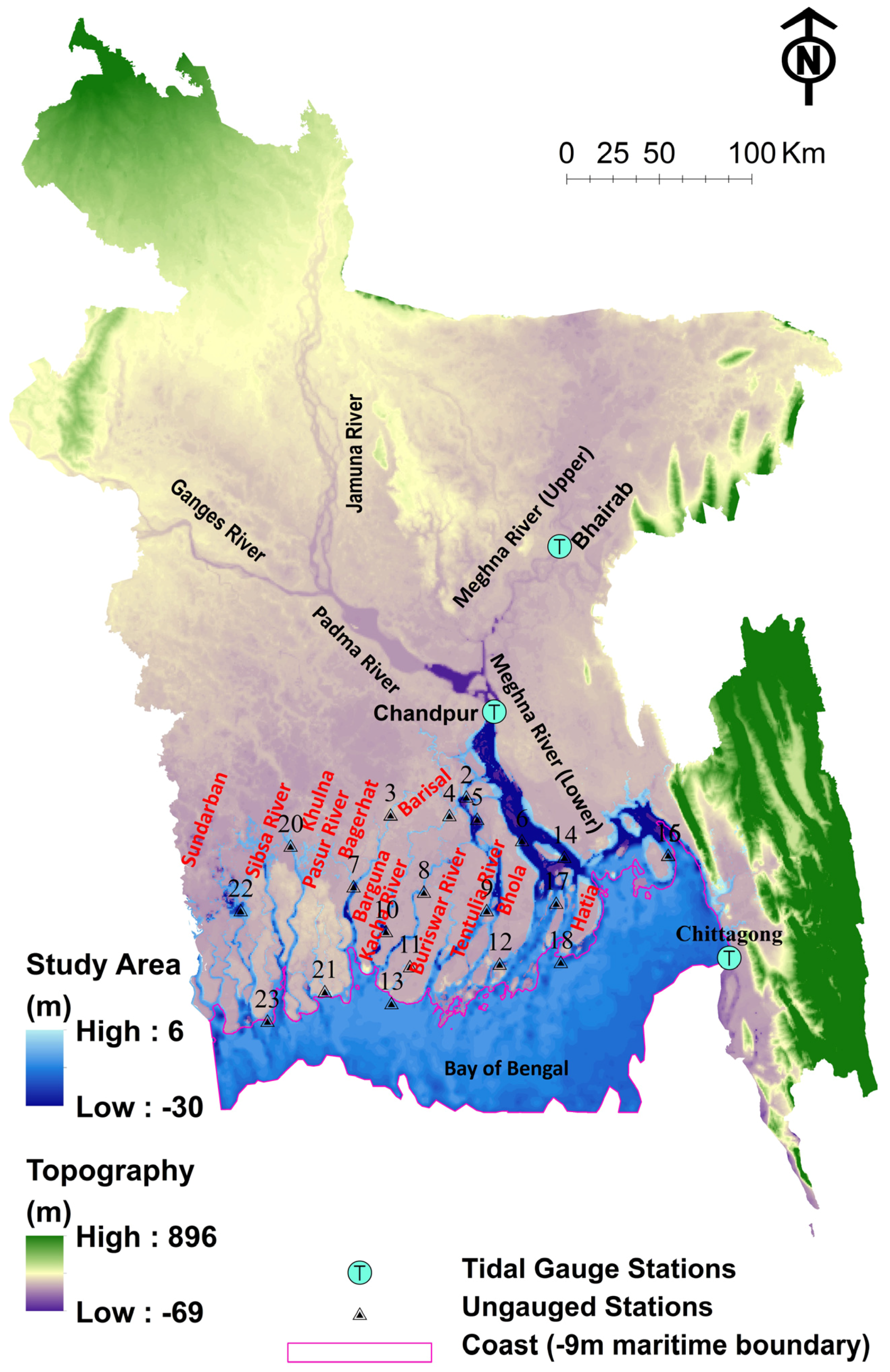

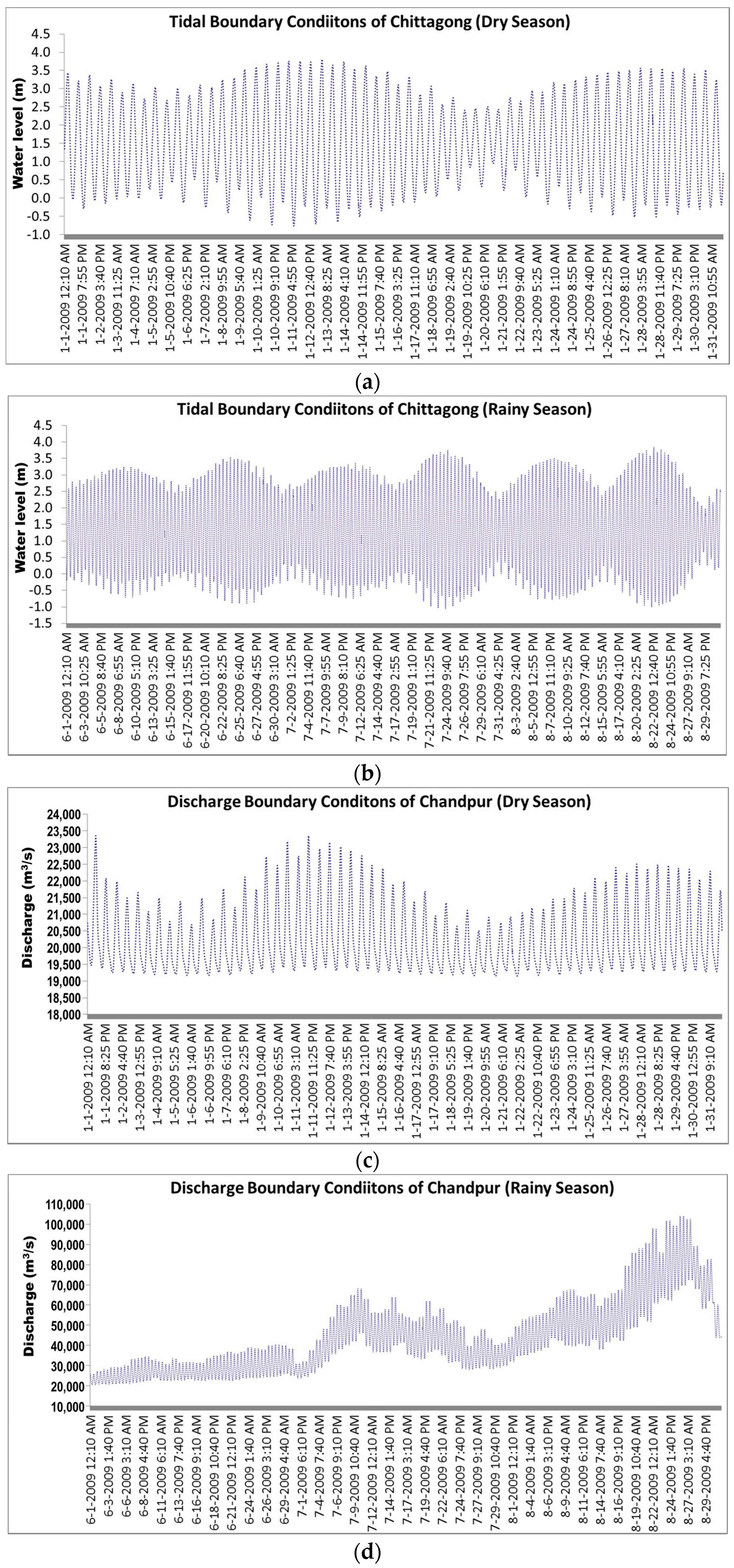
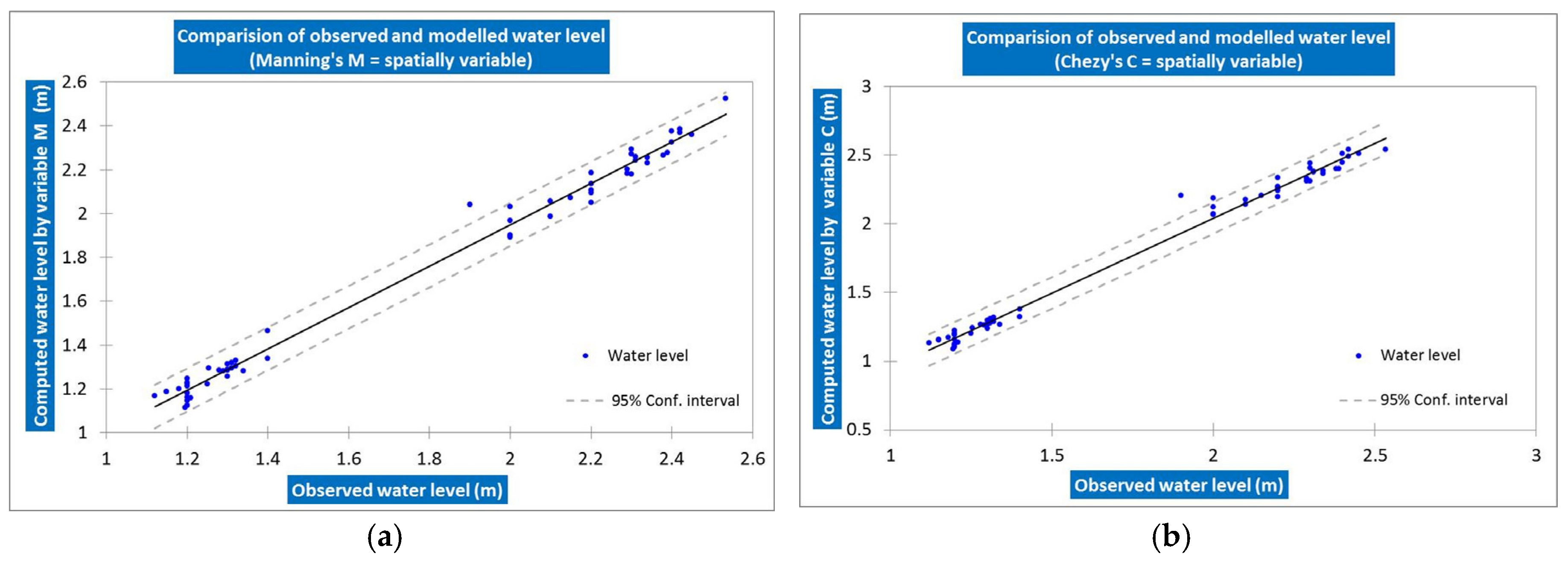
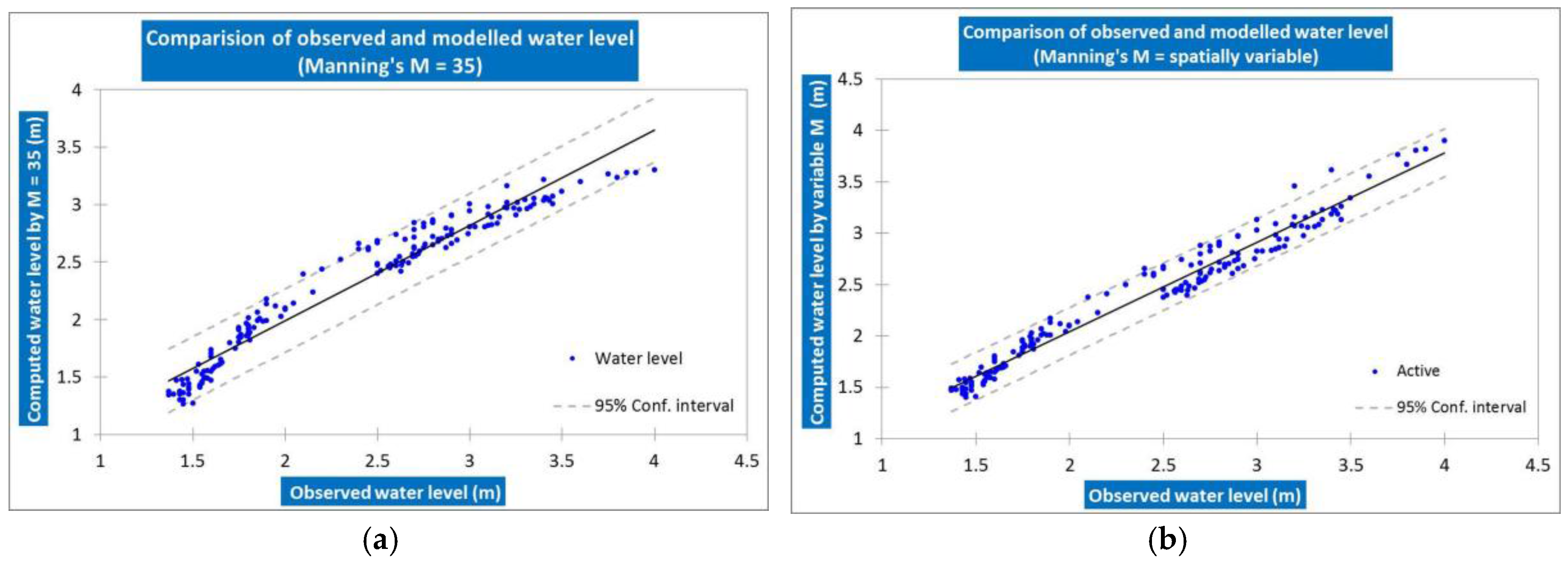

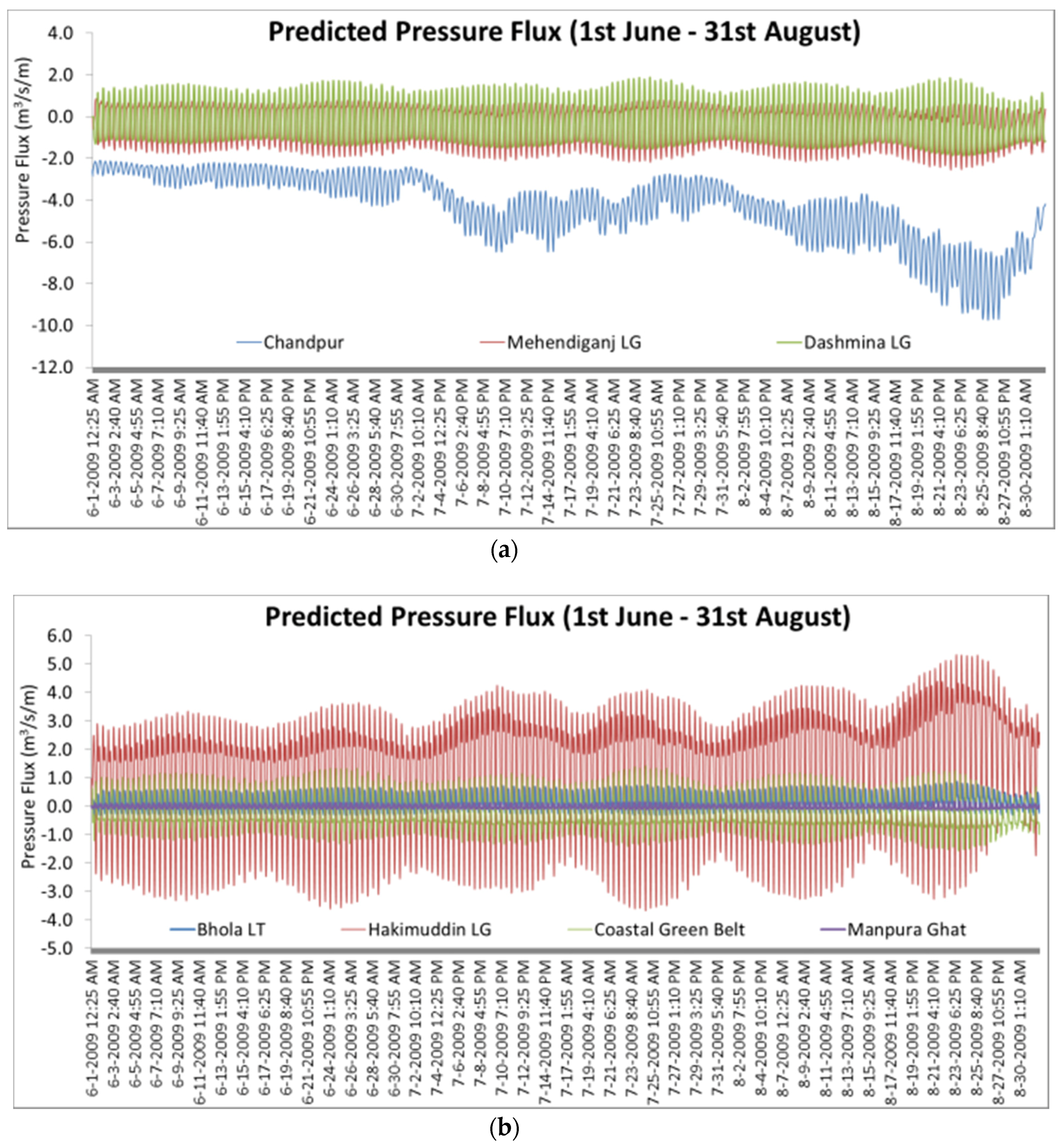
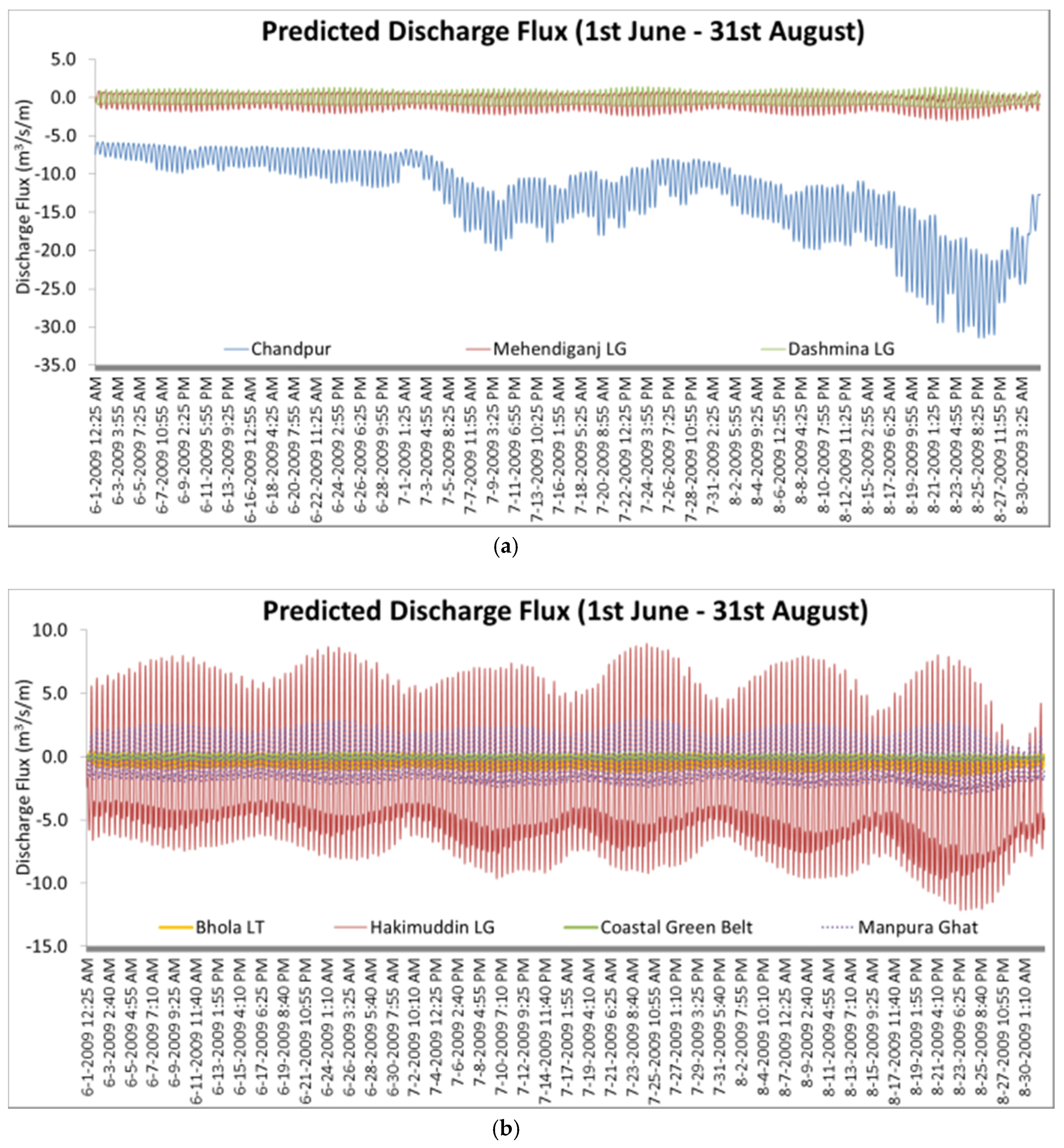
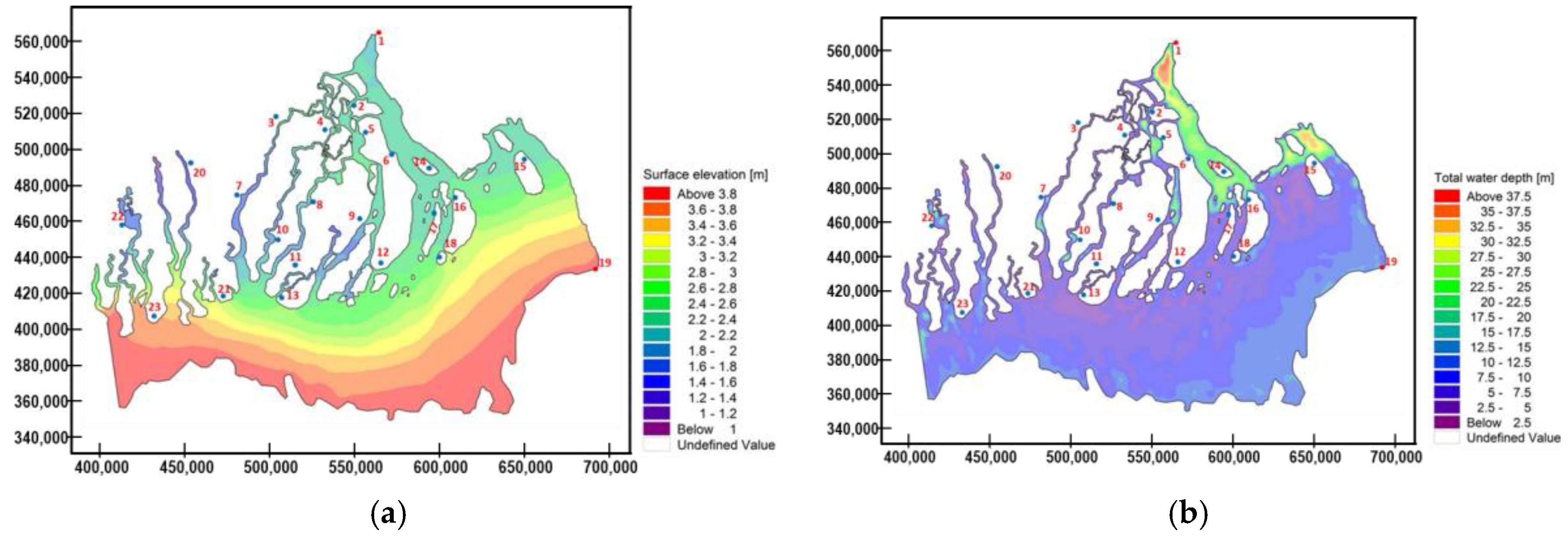
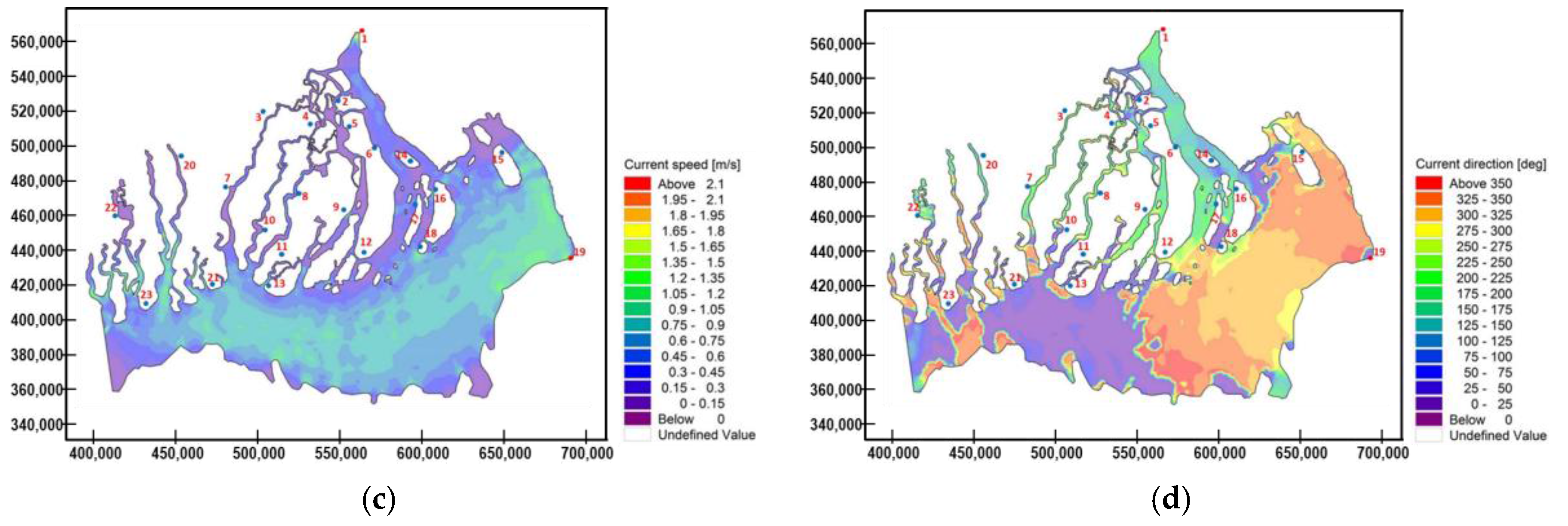
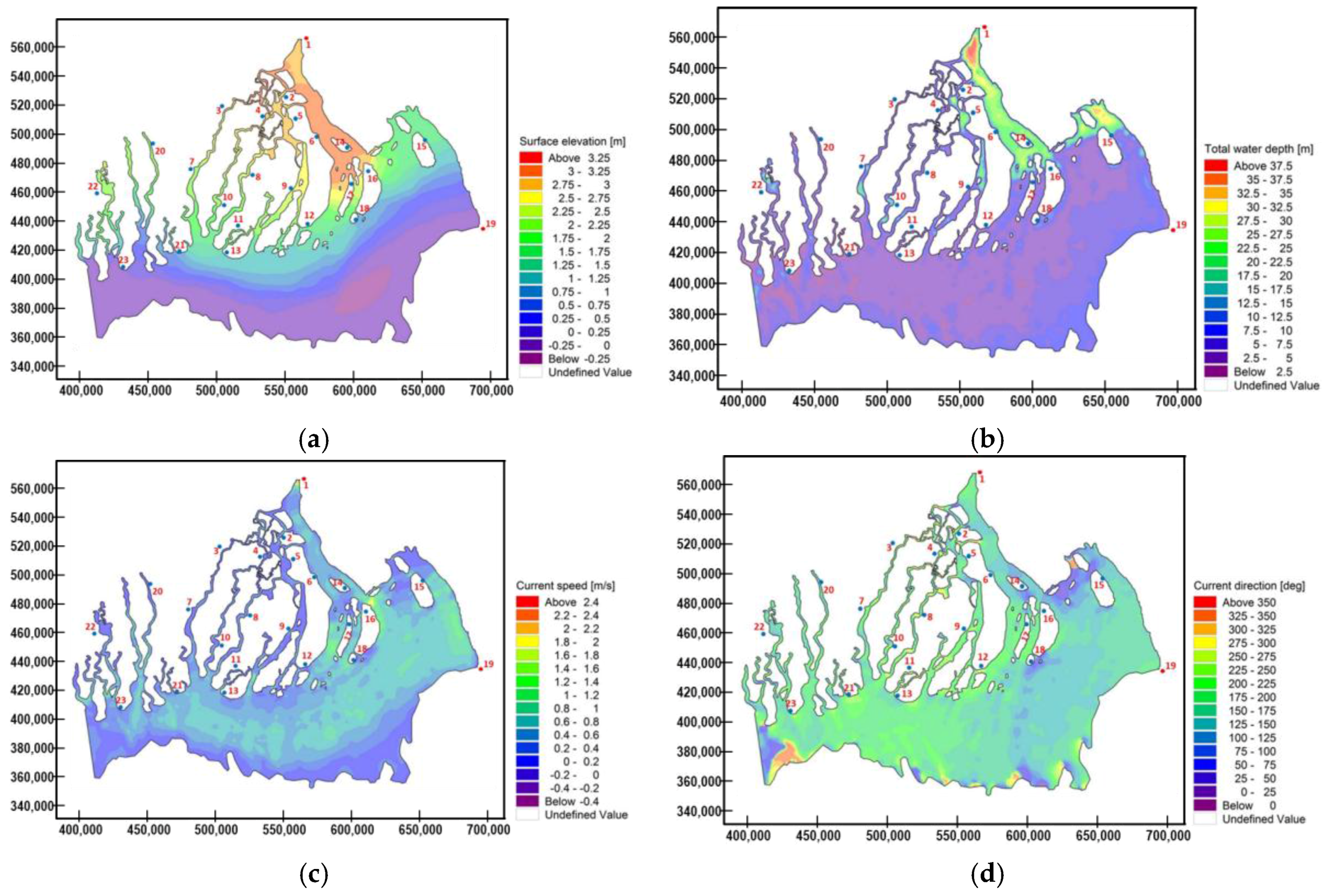
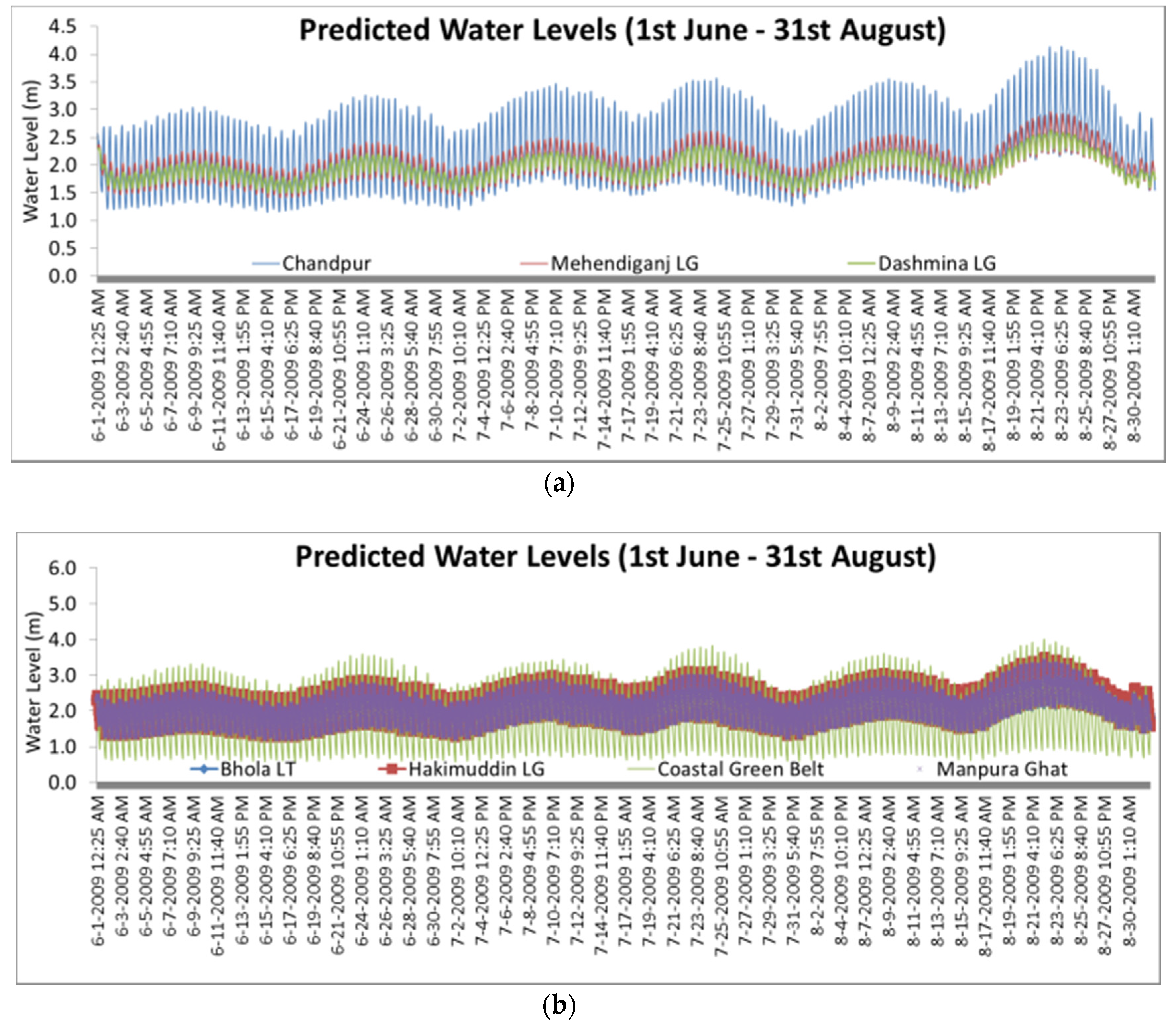
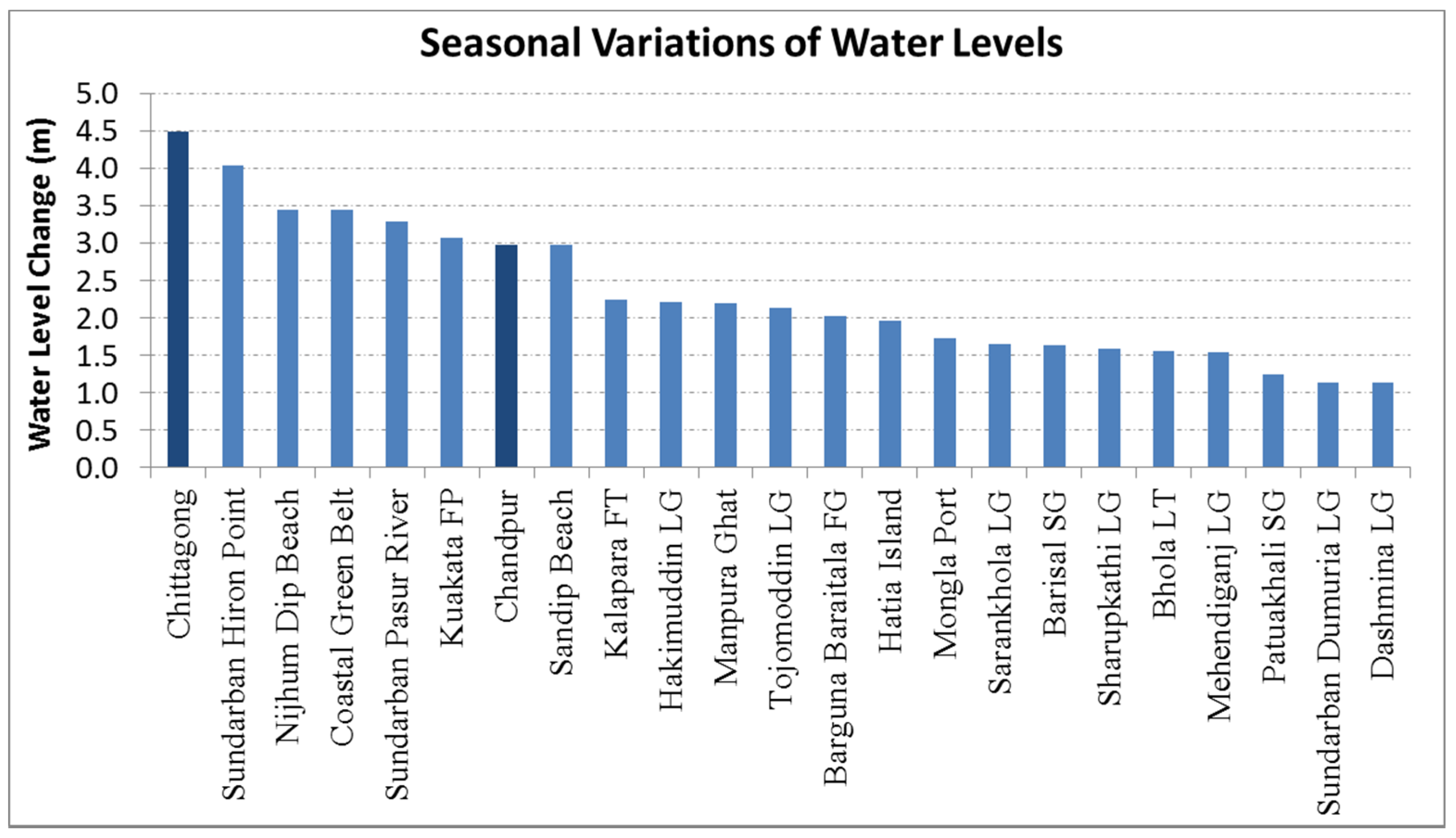
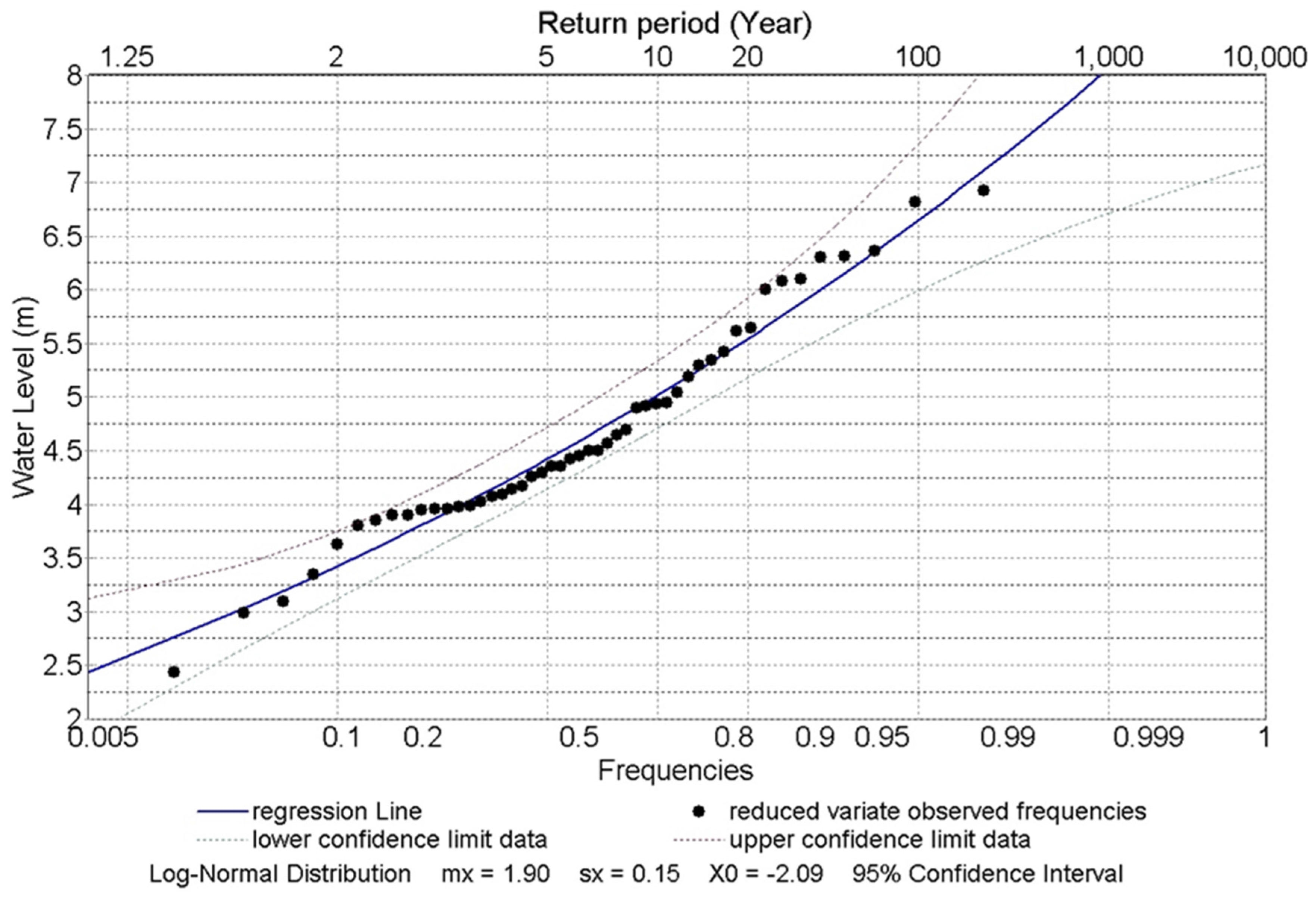

| Fitting Parameter | Chandpur Station | |
|---|---|---|
| Manning Variable (Ripple Sand) | Chezy Variable (Ripple Sand) | |
| Observation | 62 | 62 |
| R2 | 0.988 | 0.997 |
| MSE (m) | 0.003 | 0.001 |
| RMSE (m) | 0.055 | 0.035 |
| MAPE (%) | 2.216 | 2.014 |
| Fitting Parameter | Manning Constant (35) | Chezy Constant (40) | Manning Variable (Ripple Sand) | Chezy Variable (Ripple Sand) |
|---|---|---|---|---|
| Observations | 174 | 174 | 174 | 174 |
| R² | 0.954 | 0.967 | 0.968 | 0.983 |
| MSE (m) | 0.017 | 0.007 | 0.012 | 0.013 |
| RMSE (m) | 0.130 | 0.084 | 0.111 | 0.115 |
| MAPE (%) | 4.981 | 3.012 | 3.919 | 3.885 |
| St. No | Name | East | North | ∆t * (h) | Predicted Water Level (m) | Water Level Return Periods (Year) | |||||
|---|---|---|---|---|---|---|---|---|---|---|---|
| 2 | 5 | 10 | 25 | 50 | 100 | ||||||
| 1 | Chandpur | 564,000 | 569,500 | 5:00 | 4.13 | 3.98 | 4.44 | 5.08 | 6.22 | 6.38 | 6.70 |
| 2 | Mehendiganj LG | 549,000 | 523,600 | 6:30 | 2.97 | 2.87 | 3.20 | 3.66 | 4.48 | 4.59 | 4.82 |
| 3 | Sharupkathi LG | 508,000 | 513,900 | 6:00 | 2.51 | 2.43 | 2.71 | 3.10 | 3.80 | 3.89 | 4.09 |
| 4 | Barisal SG | 539,800 | 513,600 | 6:30 | 3.02 | 2.91 | 3.24 | 3.71 | 4.54 | 4.66 | 4.89 |
| 5 | Bhola LT | 554,800 | 511,600 | 6:45 | 2.96 | 2.83 | 3.15 | 3.61 | 4.42 | 4.53 | 4.76 |
| 6 | Hakimuddin LG | 579,000 | 500,000 | 4:30 | 3.49 | 3.19 | 3.55 | 4.07 | 4.98 | 5.10 | 5.36 |
| 7 | Sarankhola LG | 488,000 | 475,000 | 4:15 | 2.79 | 2.69 | 3.00 | 3.43 | 4.20 | 4.31 | 4.52 |
| 8 | Chittagong | 691,000 | 436,000 | 0:00 | 3.88 | 3.84 | 4.92 | 5.02 | 5.22 | 5.29 | 5.50 |
| 9 | Dashmina LG | 560,000 | 462,000 | 7:00 | 2.64 | 2.62 | 2.66 | 2.72 | 2.83 | 2.87 | 2.98 |
| 10 | Barguna FG | 505,500 | 450,600 | 3:15 | 3.1 | 3.05 | 3.10 | 3.16 | 3.29 | 3.33 | 3.47 |
| 11 | Kalapara FT | 518,500 | 431,600 | 2:45 | 3.24 | 3.22 | 3.27 | 3.34 | 3.47 | 3.52 | 3.66 |
| 12 | Coastal Green Belt | 567,000 | 433,000 | 2:30 | 4 | 3.97 | 4.03 | 4.12 | 4.28 | 4.34 | 4.51 |
| 13 | Kuakata FP | 508,500 | 411,600 | 1:30 | 3.61 | 3.58 | 3.64 | 3.72 | 3.86 | 3.92 | 4.07 |
| 14 | Hatia Island | 602,000 | 491,000 | 3:30 | 3.28 | 3.24 | 3.29 | 3.36 | 3.50 | 3.55 | 3.69 |
| 15 | Sandip Beach | 658,000 | 492,000 | 2:00 | 3.65 | 3.63 | 3.69 | 3.77 | 3.92 | 3.97 | 4.13 |
| 16 | Tojumoddin LG | 658,000 | 492,000 | 3:00 | 3.4 | 3.39 | 3.44 | 3.52 | 3.66 | 3.71 | 3.85 |
| 17 | Manpura Ghat | 597,500 | 466,000 | 3:15 | 3.4 | 3.36 | 3.42 | 3.49 | 3.63 | 3.68 | 3.82 |
| 18 | Nijhum Dip Beach | 600,000 | 434,000 | 1:45 | 3.81 | 3.77 | 3.83 | 3.92 | 4.07 | 4.13 | 4.29 |
| 19 | Patuakhali SG | 526,000 | 472,000 | 4:30 | 2.68 | 2.66 | 2.70 | 2.76 | 2.87 | 2.91 | 3.03 |
| 20 | Mongla Port | 454,000 | 497,000 | 5:00 | 2.74 | 2.71 | 2.75 | 2.81 | 2.92 | 2.96 | 3.08 |
| 21 | Sundarban Pasur | 472,500 | 418,000 | 1:30 | 3.64 | 3.63 | 3.69 | 3.77 | 3.92 | 3.97 | 4.13 |
| 22 | Sundarban Dumuria LG | 427,000 | 462,000 | 4:45 | 2.36 | 2.33 | 2.37 | 2.42 | 2.52 | 2.55 | 2.65 |
| 23 | Sundarban Hiron Point | 441,500 | 402,000 | 1:00 | 3.91 | 3.87 | 3.93 | 4.02 | 4.18 | 4.23 | 4.40 |
© 2018 by the authors. Licensee MDPI, Basel, Switzerland. This article is an open access article distributed under the terms and conditions of the Creative Commons Attribution (CC BY) license (http://creativecommons.org/licenses/by/4.0/).
Share and Cite
Syed, Z.H.; Choi, G.; Byeon, S. A Numerical Approach to Predict Water Levels in Ungauged Regions—Case Study of the Meghna River Estuary, Bangladesh. Water 2018, 10, 110. https://doi.org/10.3390/w10020110
Syed ZH, Choi G, Byeon S. A Numerical Approach to Predict Water Levels in Ungauged Regions—Case Study of the Meghna River Estuary, Bangladesh. Water. 2018; 10(2):110. https://doi.org/10.3390/w10020110
Chicago/Turabian StyleSyed, Zakir Hossein, Gyewoon Choi, and Seongjoon Byeon. 2018. "A Numerical Approach to Predict Water Levels in Ungauged Regions—Case Study of the Meghna River Estuary, Bangladesh" Water 10, no. 2: 110. https://doi.org/10.3390/w10020110





